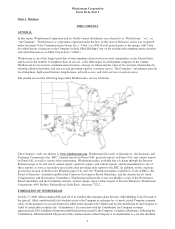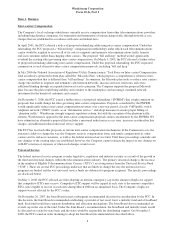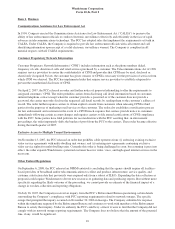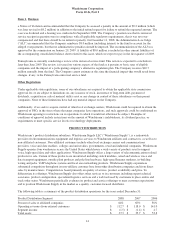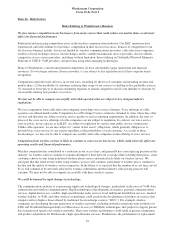Windstream 2008 Annual Report Download - page 58
Download and view the complete annual report
Please find page 58 of the 2008 Windstream annual report below. You can navigate through the pages in the report by either clicking on the pages listed below, or by using the keyword search tool below to find specific information within the annual report.
Windstream Corporation
Form 10-K, Part I
Item 1. Business
Communications Assistance for Law Enforcement Act
In 1994, Congress enacted the Communications Assistance for Law Enforcement Act (“CALEA”) to preserve the
ability of law enforcement officials to conduct electronic surveillance effectively and efficiently in the face of rapid
advances in telecommunications technology. The FCC has adopted rules that implement the requirements set forth in
CALEA. Under CALEA, the Company is required to provide law enforcement officials with call content and call
identifying information upon receipt of a valid electronic surveillance warrant. The Company is compliant in all
material respects with all CALEA requirements.
Customer Proprietary Network Information
Customer Proprietary Network Information (“CPNI”) includes information such as the phone numbers dialed,
frequency of calls, duration of calls and retail services purchased by a customer. The Telecommunications Act of 1996
requires service providers to ensure the confidentiality of CPNI and provides that CPNI may be used, disclosed or
shared only if required by law, the customer has given consent, or CPNI is necessary for the provision of services from
which CPNI was derived. The FCC has implemented rules that require service providers to establish safeguards to
prevent the unauthorized disclosure of CPNI.
On April 2, 2007, the FCC released an order and further notice of proposed rulemaking to alter the requirements to
safeguard customers’ CPNI. The order prohibits carriers from disclosing call detail information based on customer-
initiated telephone contact except when the customer provides a password or, if the customer does not provide a
password, the carrier may only disclose the requested call detail records by sending them to the customer’s address of
record. The order further requires carriers to obtain explicit consent from customers when releasing CPNI to third
parties for the purposes of marketing retail services to that customer. The order also establishes a notification process
for law enforcement and customers in the event of a CPNI breach, requires that carriers provide notice to customers
immediately following certain account changes and requires carriers to file annual certifications of CPNI compliance
with the FCC. Some parties have filed petitions for reconsideration with the FCC asserting that, in enforcement
proceedings, the order improperly shifts the burden of proof from the FCC to the carriers. These rules became effective
during the fourth quarter of 2007.
Exclusive Access to Multiple Tenant Environments
On November 13, 2007, the FCC released an order that prohibits cable operators from: (i) enforcing existing exclusive
video service agreements with multi-dwelling unit owners; and (ii) entering new agreements containing exclusive
video service rights for multi-dwelling units. Currently this order is being challenged in court, but assuming it goes into
effect, the order expands Windstream’s potential customer base for video, voice, and high-speed internet services in the
near term.
Other Federal Regulations
On September 6, 2008, the FCC released an NPRM tentatively concluding that the agency should require all facilities-
based providers of broadband and/or telecommunications to collect and produce infrastructure, service quality, and
customer satisfaction data that previously were required only from a subset of ILECs. Expanding the data collection as
proposed could require Windstream to devote new resources to gathering data and producing reports. But without more
specificity regarding the likely outcome of the proceeding, we cannot provide an estimate of the financial impact of a
change in our data collection and reporting obligations.
On July 26, 2007, the Company received an inquiry from the FCC’s Enforcement Bureau questioning certain details
surrounding the Company’s compliance with FCC reporting requirements related to network outages. The specific
outage that prompted the inquiry occurred on November 30, 2006 in Georgia. The Company submitted its response
within the timeframe requested by the Enforcement Bureau and continues to work with members of the Enforcement
Bureau to satisfy their inquiry. Under its authority the FCC could levy a fine if it were to find that the Company did not
comply with its network outage reporting requirements. The Company does not believe that the amount of the potential
fine, if any, would be significant.
10




